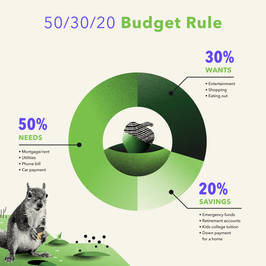How Much Should I Have in Savings?

We all know that we should be saving money in order to prepare for the future. And while “saving money” sounds like it should be a relatively easy thing to do, it does come with some important questions: How much should you have in savings? What kind of savings account should you be using? Are saving and investing the same thing? And how do you get started?
Below, we answer these and other important questions so that you can feel confident in your savings strategy.
Why do I need savings?
If you make a decent salary or wage, always pay your bills on time, never rely on your credit cards, and still have spare money leftover in your checking account each month, it might be tempting to think that you don’t need to be saving money. Why open a savings account if you’ve got plenty of money to go around?
The simple answer? Because we can’t predict the future.
While you may have a high-paying job now, there’s no guarantee that you’ll always have that same high-paying job. As we’ve seen with the coronavirus pandemic and the economic havoc it’s caused, bear markets and recessions can come on with shocking speed, forcing companies to lay off thousands of workers and restructure their operations. Without adequate savings, millions of Americans are finding themselves reliant on unemployment benefits to survive, even as these benefits don’t fully replace their salary.
While the potential for job loss is a major risk, and a major argument for why individuals should have savings, it isn’t the only one. As an estimated 80 percent of Americans are living paycheck to paycheck, it might take just one unexpected expense to completely blow your budget.
Saving money allows us to put aside the excess that we have now in order to prepare for the uncertainty that the future holds.
How much do I need in my savings account?
Unfortunately, there is no hard and fast answer to that question. How much you want to have in savings ultimately relies on a number of factors, including what it is that you’re saving for. Two ways you can think about this is to split your savings into your emergency savings and then anything you’re saving for specific goals.
Creating an emergency savings fund
An emergency savings fund is exactly what it sounds like: A savings account that holds money specifically to help you cover emergency expenses. Most financial experts recommend that you should aim to create an emergency fund that eventually holds enough to cover three to six months’ worth of basic expenses, in order to help you get through periods of job loss.
Not sure how much that translates into in terms of dollar amount? Follow the steps below to determine how much you should have in your emergency savings fund:
1. Audit your spending.
To understand how much you should be saving, you first need to understand how much you spend each month on essentials. Sit down with your previous month’s statements and take a look at where you spent your money.
For the purposes of your emergency fund, you want to pay particular attention to what you spend on essential expenses from rent and utilities to transportation costs to recurring medical expenses, groceries, debt payments, childcare expenses, insurance, etc. You can exclude anything that is optional, such as entertainment or take-out. Don’t forget to include expenses that you pay once a year or once every six months, such as car insurance or property taxes.
2. Create a budget.
While you’re auditing your spending, you may as well use the time to create a budget. This will help you record where you are currently spending your money, and can help you find ways to save and add to your emergency fund once you know how much you need. (One helpful approach is the 50/30/20 rule, which allocates 50% of take-home pay for essentials, 30% for flexible spending like take-out meals or books or entertainment, and 20% for saving, investing and additional debt payments.)
3. Add it all together.
After you’ve got your list of essential monthly expenses listed out, tally them up. This is how much money you will need to save in order to cover a single month’s worth of expenses. Multiply that number by either three or six to determine how much money you should ultimately aim to save in order to hit the recommended total. There are a number of emergency fund calculators out there that can help you do this math.
4. Remember you can start small.
While that number may seem intimidating, remember that you can start small. Aim first to set aside $100. Then, gradually build your savings up to $500, and then $1,000. Having this much money set aside will help you cover most common unexpected expenses that you might encounter like a car repair or unexpected medical bill, and should be relatively easy for most of us to reach. Once you’ve got $1,000 saved, continue adding to your savings until you reach the recommended amount.
Saving for short-term goals
When it comes to other, elective savings, how much you choose to save will ultimately depend on your goals. Choosing a timeline for when you want to make a purchase and a budget of how much you expect to spend can be an excellent means of guiding you in answering this question.
For example, if you’re planning on going on a vacation in six months, and you know it will cost you $2,000, you can divide $2,000 by six to determine that you’d need to save $333 per month to hit your goal.
Similarly, if you want to buy a house in five years time, and expect to pay $300,000 for the home, then your down payment would be approximately 20 percent of that total, or $60,000. By dividing $60,000 by five, you’d determine that you’d need to save $12,000 each year, or $1,000 each month, to hit your goal.
What kind of savings account should you use?
Choosing a savings account that offers the highest interest rate possible will help you grow your savings and hit your goals faster compared to an account that offers a lower interest rate.
Money market accounts (MMAs) and high-yield savings accounts are two options that offer higher interest yields compared to everyday savings accounts. Check to make sure the account you choose is FDIC-insured, which means that you have no risk of losing your money if the bank goes under—an important consideration when deciding where to park your savings.
There are also some important differences between the two types of accounts that you should understand.
High-Yield Savings Account
A high-yield savings account is simply a savings account that offers a higher interest yield compared to the average interest rate you can expect to find at many big banks. High-yield savings accounts are often offered by smaller regional banks or credit unions, as a way to attract customers. In order to qualify for higher rates you may need to meet certain requirements, such as holding a minimum balance (which can be as high as $10,000).
One potential downside? High-yield savings accounts often do not come with checks or debit cards. This means you may need to actually visit your bank to make a withdrawal, which can make accessing your money a bit more challenging should you need it in a hurry. That being said, this may also help you avoid tapping it for non-emergencies, which could be a good thing.
Money Market Accounts (MMAs)
Like high-yield savings accounts, money market accounts often offer higher interest rates compared to the average savings account. But, importantly, MMAs tend to be a bit more accessible: They are more likely to offer checkbooks or debit cards, which can make it easier for you to get to your money in event of an emergency. And, while these accounts do typically earn more in interest compared to regular savings accounts, many high-yield savings accounts offer higher rates.
Choosing Your Account
Just as you should diversify your investments to reduce the risk of losing your money, it can be wise to split your emergency savings between multiple different accounts to help you realize the different benefits that different types of accounts offer. For example, you might:
Keep $500 in a savings account linked to your checking account. so that it is accessible to you should you need it quickly, even if it doesn’t earn much in interest.
Keep 25 percent of your emergency savings in an MMA, so it earns a higher interest rate compared to your regular savings account while also being accessible during emergencies.
Keep the rest of your emergency fund in a high-yield savings account, where it can earn as much interest as possible while also being harder to access, so that you are less inclined to access it for expenses that aren’t emergencies.
How is saving different from investing?
While saving and investing both involve you setting aside money for the future, they are different in important ways. It’s important for you to understand these differences so that you can be sure you’re taking the most appropriate course of action for your particular goals. These differences include:
1. Risk
Saving money should rarely involve risk. So long as your savings sit in an FDIC-insured account, which protects up to $250,000, you don’t need to worry about losing your money.
Investing, on the other hand, does involve risk. Stocks offer the potential for high returns, but can also lose value—though, historically, the stock market has trended up significantly, there have been regular periods of volatility. Even investments that are considered relatively safe and steady like bonds involve taking on some risk that could cause you to lose money. (That’s why it’s important to check bond ratings.)
2. Potential for Growth
While savings accounts are safe, they also typically offer very little in terms of growth potential. Yes, you will earn at least some interest on the money you hold in a savings account. But for the vast majority of savings accounts, this will be less than one percent, and even high-yield savings accounts were topping out around 1.5 to 2 percent in 2020.
Investing, on the other hand, typically offers a much higher potential for growth. This potential is typically linked to how much investment risk you’re willing to take on. Generally speaking, the greater the risk, the greater the potential for reward.
3. Timeline
Because of the risk involved in investing, it’s typically best suited for helping you reach your mid- or long-term goals. The further out you plan on needing your money, the more likely you will be able to recover from the market volatility or fluctuations that are inherent in investing in stocks.
The virtually nonexistent risk associated with saving, on the other hand, makes it better suited towards short-term goals, when you don’t have a lot of time to recover from potential market declines, or when you don’t know when you will need to access your money (such as in an emergency).
4. Accessibility
Even a high-yield savings account that requires you to visit a branch in person to access your money is likely to offer more accessibility compared to investing.
In order to access the money held in an investment account, you will need to sell those assets, which takes time. You may also find yourself needing to pay a penalty or taxes, depending on the type of assets you’re selling. Tapping a retirement fund before you are full retirement age, for example, may involve paying taxes and penalties.
When should I tap my savings?
When it comes to tapping your emergency savings, it’s important to remember that the money should truly only be used for emergencies. These might include:
- An unexpected trip to the doctor or dentist
- Replacing a broken pair of glasses
- An emergency visit to the veterinarian
- A critical home or car repair
- Unexpected travel for a funeral or to care for a loved one
- Replacing a piece of equipment you need to do your job (such as a laptop for remote workers, or a camera for a professional photographer)
- Covering your living expenses during a period of unemployment, which causes you to lose your job
Generally speaking, money that you are saving for other uses (like a vacation, etc.) can be used for other needs so long as you understand the tradeoff you are making. If you decide you would rather use the money you’ve been saving for a new camera to instead fund a vacation, that’s fine. Similarly, if you’ve been saving to go on vacation but now find yourself unable to leave the country, you can feel okay in using that money elsewhere. General savings can also be used to cover an emergency, should one arise.
Saving for the Unexpected
An easy way to think about saving is that it’s an insurance policy against an unknown future. By saving money today, you can feel confident that you will be prepared to weather whatever challenges the world throws at you. The first step in reaching this goal is to determine exactly how much you should be saving to begin with.
This article contains the current opinions of the author, but not necessarily those of Acorns. Such opinions are subject to change without notice. This article has been distributed for educational purposes only and should not be considered as investment advice or a recommendation of any particular security, strategy or investment product. Information contained herein has been obtained from sources believed to be reliable, but not guaranteed.
This material has been presented for informational and educational purposes only. The views expressed in the articles above are generalized and may not be appropriate for all investors. The information contained in this article should not be construed as, and may not be used in connection with, an offer to sell, or a solicitation of an offer to buy or hold, an interest in any security or investment product. There is no guarantee that past performance will recur or result in a positive outcome. Carefully consider your financial situation, including investment objective, time horizon, risk tolerance, and fees prior to making any investment decisions. No level of diversification or asset allocation can ensure profits or guarantee against losses. Article contributors are not affiliated with Acorns Advisers, LLC. and do not provide investment advice to Acorns’ clients. Acorns is not engaged in rendering tax, legal or accounting advice. Please consult a qualified professional for this type of service.








